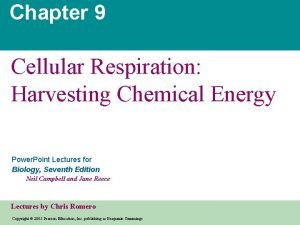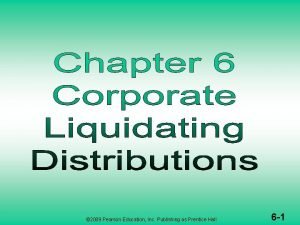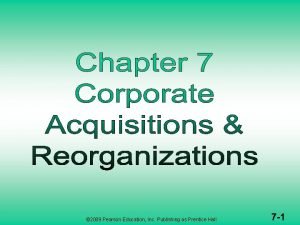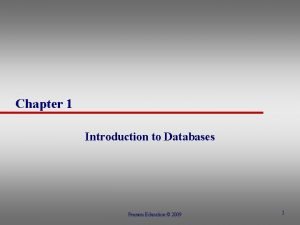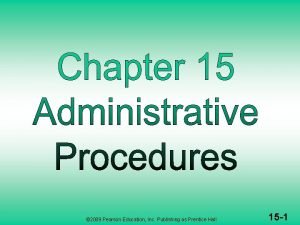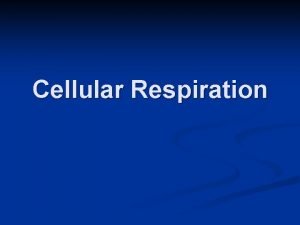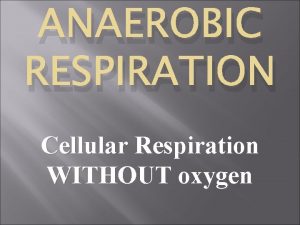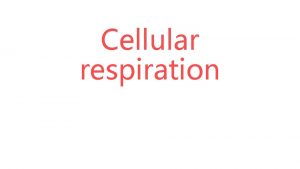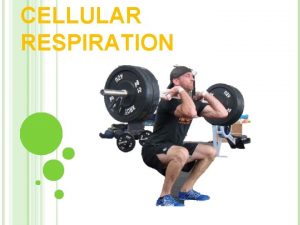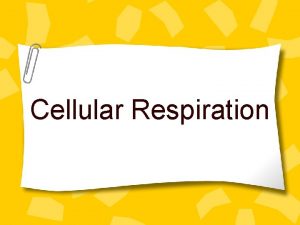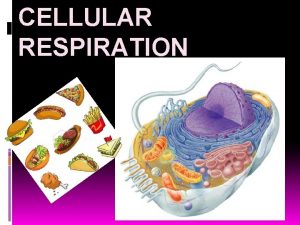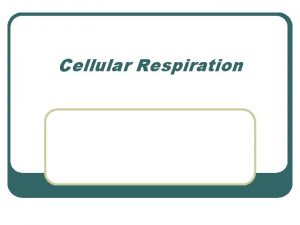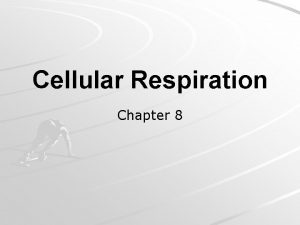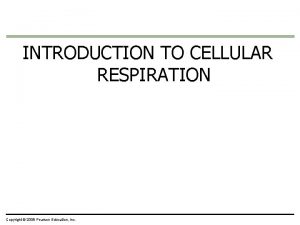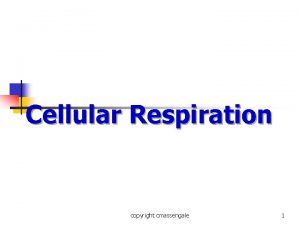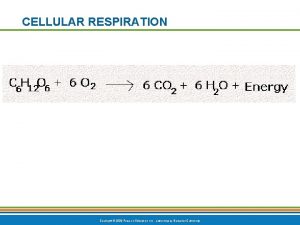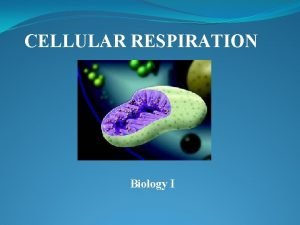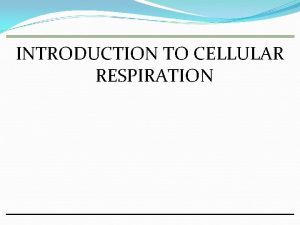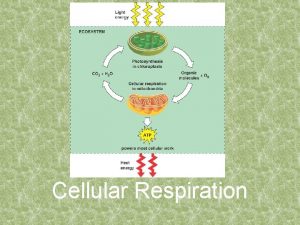INTRODUCTION TO CELLULAR RESPIRATION Copyright 2009 Pearson Education


























- Slides: 26

INTRODUCTION TO CELLULAR RESPIRATION Copyright © 2009 Pearson Education, Inc.

Photosynthesis and cellular respiration - energy for life § Together, these two processes are responsible for the majority of life on Earth Sunlight energy ECOSYSTEM Photosynthesis in chloroplasts CO 2 Glucose H 2 O O 2 Cellular respiration in mitochondria ATP (for cellular work) Heat energy Copyright © 2009 Pearson Education, Inc.

Photosynthesis and Cellular Respiration § Why do we need Energy? § - Life processes: – Growth, transport, manufacturing, movement, reproduction, etc. Copyright © 2009 Pearson Education, Inc.

O 2 Breathing CO 2 Lungs CO 2 Bloodstream Muscle cells carrying out Cellular Respiration Glucose + O 2 CO 2 + H 2 O + ATP O 2

Cellular respiration: energy in ATP molecules § Cell respiration is exergonic (releases energy) § transfers energy from the bonds in glucose to ATP § Cellular respiration produces 38 ATP molecules from 1 glucose molecule Copyright © 2009 Pearson Education, Inc.

Energy from Electrons § Carbon-hydrogen bonds of glucose are broken § Electrons transfer to oxygen – Oxygen attracts electrons- why? Copyright © 2009 Pearson Education, Inc.

Energy from Electrons § Equation shows changes in hydrogen atom distribution – Glucose loses hydrogen atoms – converted to CO 2 – O 2 gains hydrogen atoms – converted to H 2 O – Loss of electrons- oxidation – Gain of electrons- reduction LEO goes GER Copyright © 2009 Pearson Education, Inc.

Loss of hydrogen atoms (oxidation) C 6 H 12 O 6 + 6 O 2 6 CO 2 + 6 H 2 O + Energy (ATP) Glucose Gain of hydrogen atoms (reduction)

STAGES OF CELLULAR RESPIRATION Copyright © 2009 Pearson Education, Inc.

Overview: Cellular respiration occurs in three main stages § #1: Glycolysis- in cytoplasm – Breaking glucose, a sixcarbon molecule, into 2 three-carbon molecules called pyruvate Copyright © 2009 Pearson Education, Inc.

Glucose 2 ADP 2 NAD+ + 2 P 2 NADH 2 ATP + 2 H+ 2 Pyruvate

Overview: Cellular respiration occurs in three main stages § Link Reaction- in mitochondrial matrix (outer layer) – Breaks off carbon dioxide from pyruvate leaving a 2 -carbon molecule – Coenzyme A attaches to this molecule, creating Acetyl-Co. A Copyright © 2009 Pearson Education, Inc.

NADH H+ NAD+ 2 Co. A Pyruvate 1 CO 2 3 Coenzyme A Acetyl coenzyme A

Overview: Cellular respiration occurs in three main stages § #3: Citric Acid (Krebs) Cycle- in mitochondria – Breaks down pyruvate into carbon dioxide and supplies the third stage with electrons Copyright © 2009 Pearson Education, Inc.

Acetyl Co. A CITRIC ACID CYCLE 2 CO 2 3 NAD+ FADH 2 3 NADH FAD 3 H+ ATP ADP + P

Co. A Acetyl Co. A 2 carbons enter cycle Oxaloacetate 1 CITRIC ACID CYCLE Step 1 Acetyl Co. A stokes the furnace.

Co. A Acetyl Co. A 2 carbons enter cycle Oxaloacetate 1 Citrate NAD+ 2 NADH + H+ CITRIC ACID CYCLE CO 2 leaves cycle ADP + P ATP Alpha-ketoglutarate 3 CO 2 leaves cycle NADH + H+ Step 1 Acetyl Co. A stokes the furnace. NAD+ Steps 2 – 3 NADH, ATP, and CO 2 are generated during redox reactions.

Co. A Acetyl Co. A 2 carbons enter cycle Oxaloacetate 1 Citrate NADH + H+ NAD+ 5 NAD+ 2 NADH + H+ CITRIC ACID CYCLE CO 2 leaves cycle Malate ADP P FADH 2 4 ATP FAD Alpha-ketoglutarate 3 CO 2 leaves cycle Succinate NADH + H+ Step 1 Acetyl Co. A stokes the furnace. NAD+ Steps 2 – 3 NADH, ATP, and CO 2 are generated during redox reactions. Steps 4 – 5 Redox reactions generate FADH 2 and NADH.

Overview: Cellular respiration occurs in three main stages § #3: Oxidative phosphorylationinner mitochondria membrane – electrons are shuttled through the electron transport chain – ATP is generated through chemiosmosis (movement of H+ across a membrane) Copyright © 2009 Pearson Education, Inc.

Intermembrane space Protein complex of electron carriers H+ H+ Electron carrier H+ H+ ATP synthase Inner mitochondrial membrane FADH 2 Electron flow NADH Mitochondrial matrix FAD NAD+ H+ 1 2 O 2 + 2 H+ H+ H+ H 2 O Electron Transport Chain OXIDATIVE PHOSPHORYLATION ADP + P H+ Chemiosmosis ATP

NADH Mitochondrion High-energy electrons carried by NADH FADH 2 and OXIDATIVE GLYCOLYSIS Glucose PHOSPHORYLATION (Electron Transport and Chemiosmosis) CITRIC ACID CYCLE Pyruvate Cytoplasm ATP Substrate-level phosphorylation CO 2 ATP CO 2 Substrate-level phosphorylation Inner mitochondrial membrane ATP Oxidative phosphorylation

CONNECTION: Certain poisons interrupt critical events in cellular respiration § Cellular poisons that affect cellular respiration: – 1: blocks electron transport chain – rotenone, cyanide, and carbon monoxide – 2: inhibits (stops) ATP synthase – oligomycin – 3: makes the membrane leaky to hydrogen ions – dinitrophenol- used to make dyes, explosives and pesticides Copyright © 2009 Pearson Education, Inc.

Cyanide, carbon monoxide Rotenone Oligomycin H+ H+ H+ ATP synthase H+ H+ DNP FADH 2 FAD 1 2 NAD+ NADH O 2 + 2 H+ H+ H+ H 2 O H+ Electron Transport Chain ADP + P ATP Chemiosmosis

Fuel for Cell Respiration § Glucose- primary source of sugar § Three types of molecules needed to make ATP: – Carbohydrates (disaccharides) – Proteins (in form of amino acids) – Fats Copyright © 2009 Pearson Education, Inc.

Food, such as peanuts Carbohydrates Fats Glycerol Sugars Proteins Fatty acids Amino groups Glucose G 3 P Pyruvate GLYCOLYSIS Acetyl Co. A ATP CITRIC ACID CYCLE OXIDATIVE PHOSPHORYLATION (Electron Transport and Chemiosmosis)

Continue working on CR Research Guide
 Copyright 2009 pearson education inc
Copyright 2009 pearson education inc Copyright 2009 pearson education inc
Copyright 2009 pearson education inc Copyright 2009 pearson education inc
Copyright 2009 pearson education inc Copyright 2009 pearson education inc
Copyright 2009 pearson education inc 2009 pearson education inc
2009 pearson education inc 2009 pearson education inc
2009 pearson education inc Pearson cellular respiration
Pearson cellular respiration 2009 pearson education inc
2009 pearson education inc 2009 pearson education inc
2009 pearson education inc 2009 pearson education inc
2009 pearson education inc Pearson education 2009
Pearson education 2009 2009 pearson education inc
2009 pearson education inc 2009 pearson education inc
2009 pearson education inc 2017 pearson education inc
2017 pearson education inc Copyright pearson education inc
Copyright pearson education inc 2010 pearson education inc
2010 pearson education inc Copyright pearson education inc
Copyright pearson education inc 2014 pearson education inc
2014 pearson education inc Copyright 2010 pearson education inc
Copyright 2010 pearson education inc Copyright 2010 pearson education inc
Copyright 2010 pearson education inc Copyright by pearson education inc. answers
Copyright by pearson education inc. answers 2008 pearson education inc
2008 pearson education inc Copyright pearson education inc
Copyright pearson education inc Copyright 2010 pearson education inc
Copyright 2010 pearson education inc Copyright 2010 pearson education inc
Copyright 2010 pearson education inc Copyright 2010 pearson education inc
Copyright 2010 pearson education inc Copyright 2010 pearson education inc
Copyright 2010 pearson education inc






